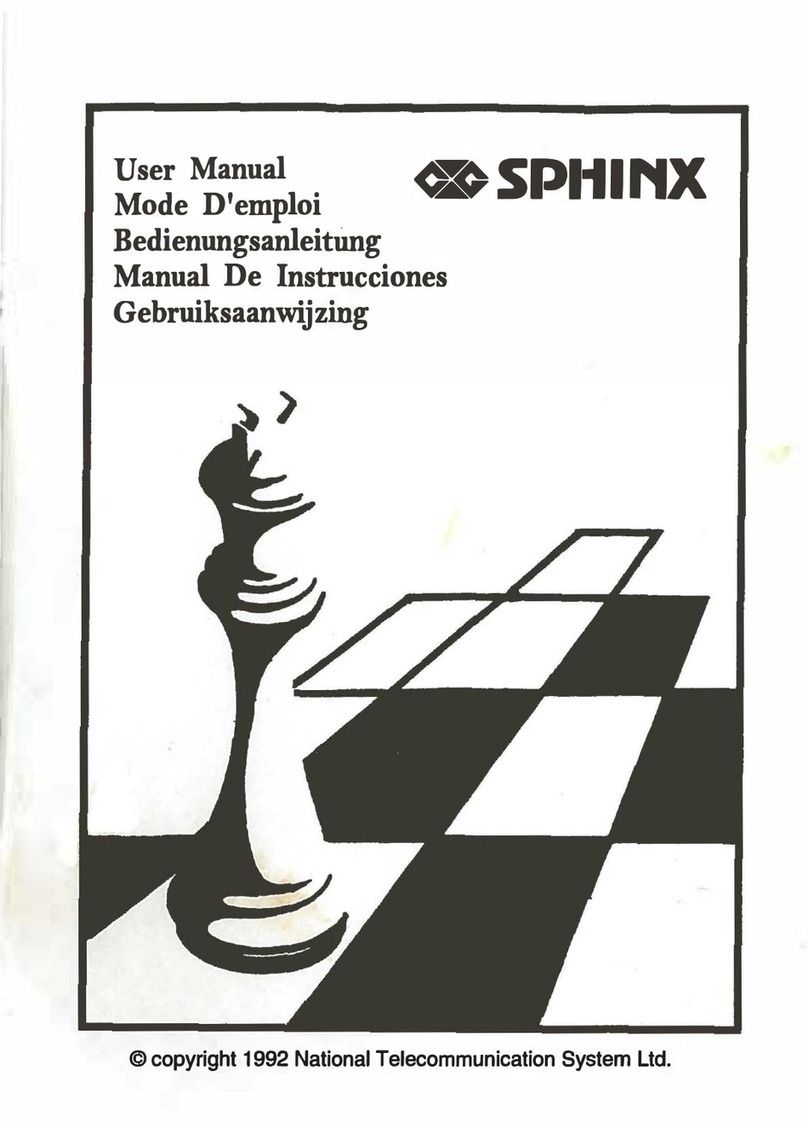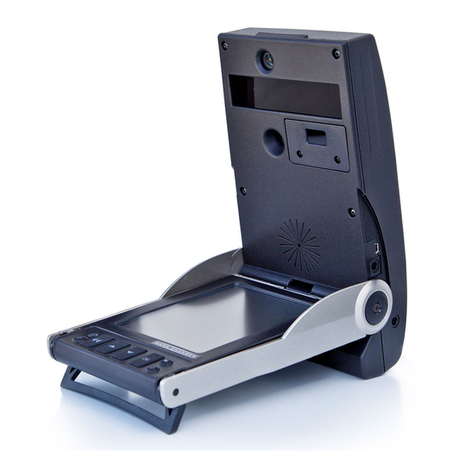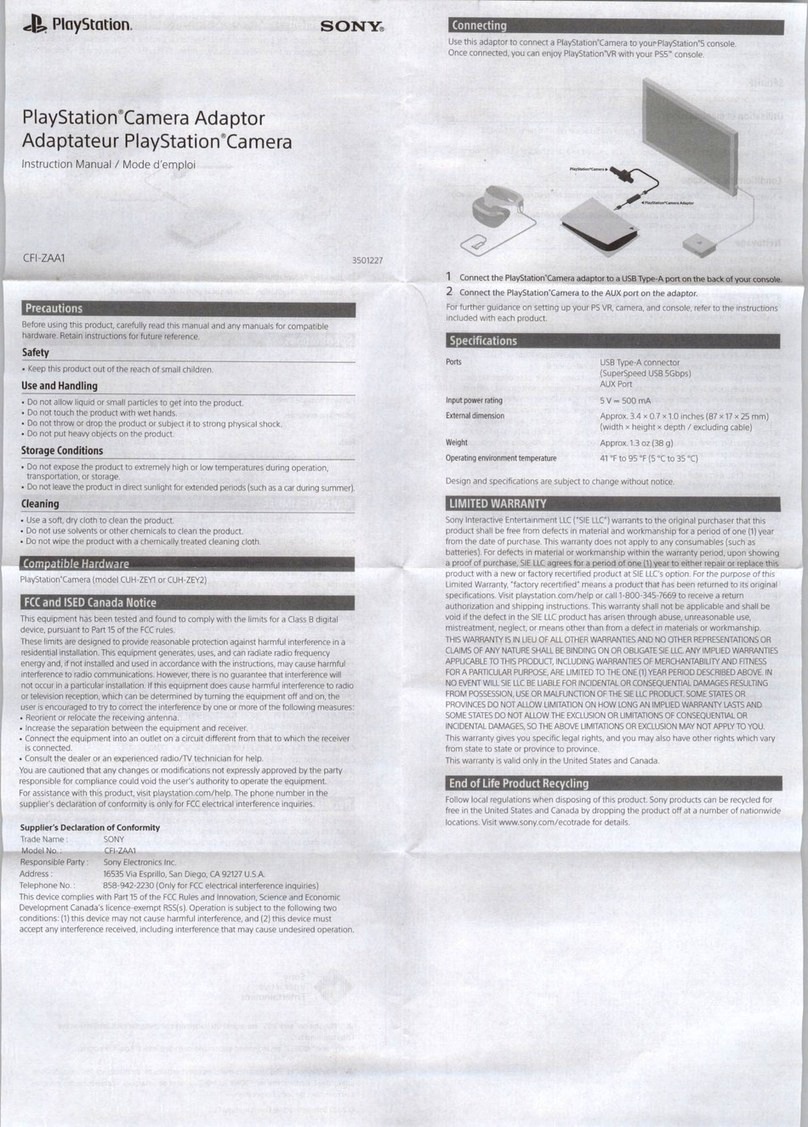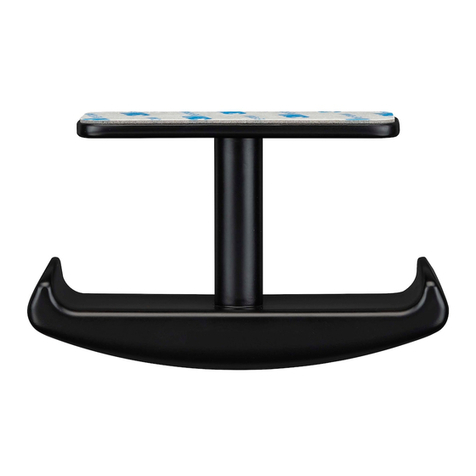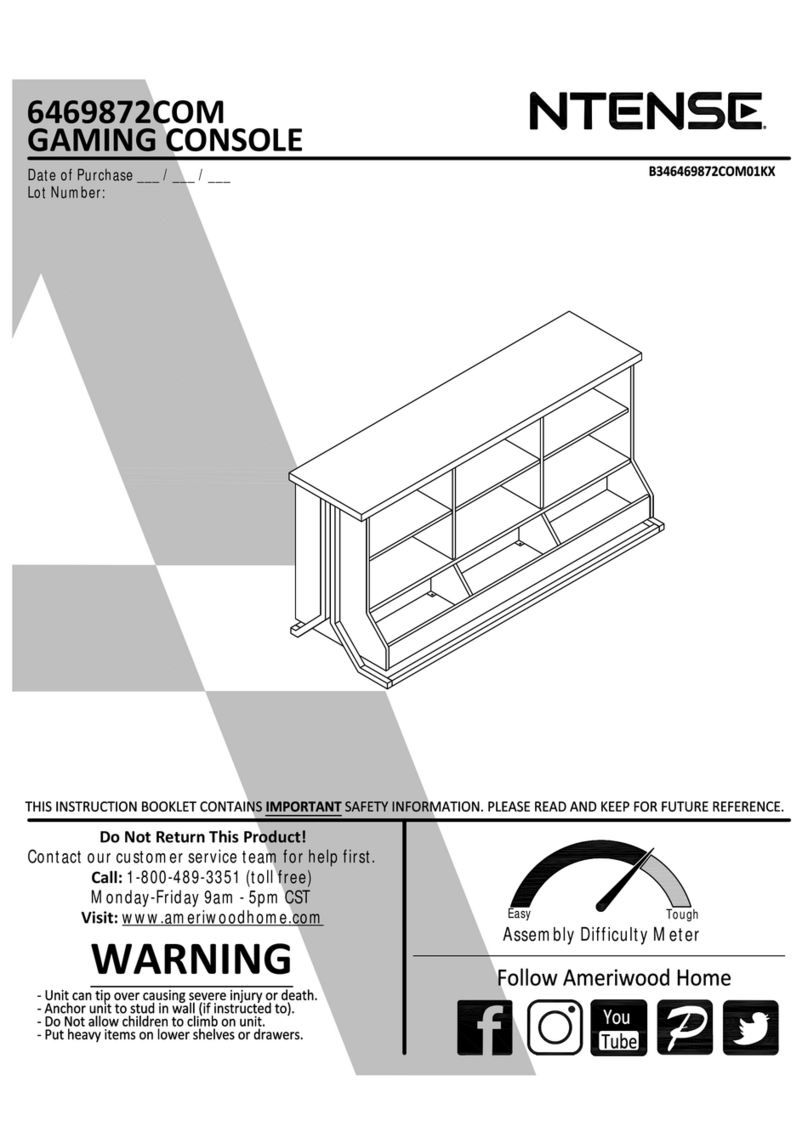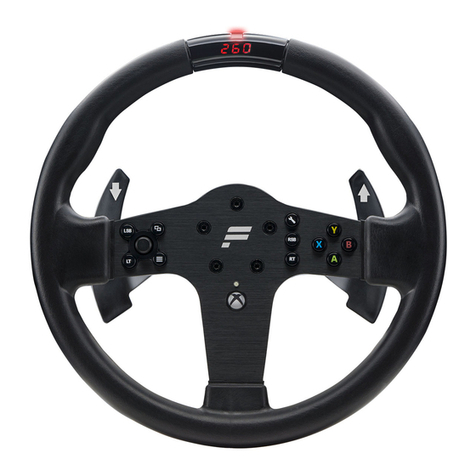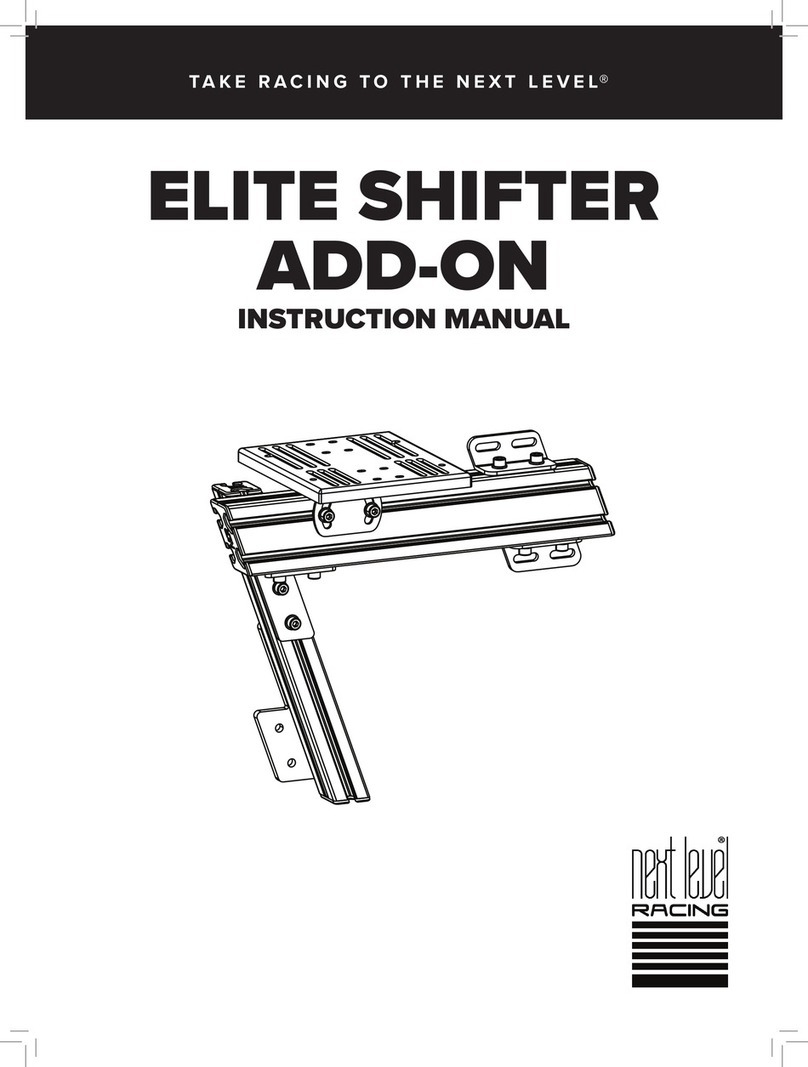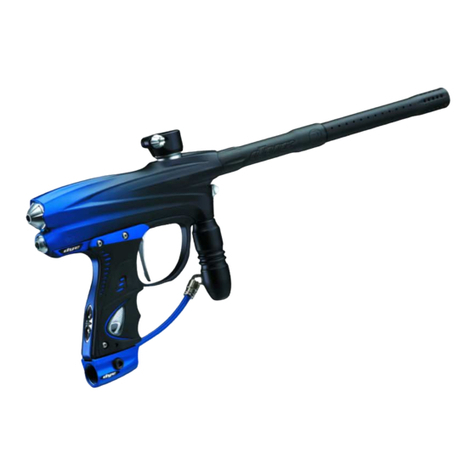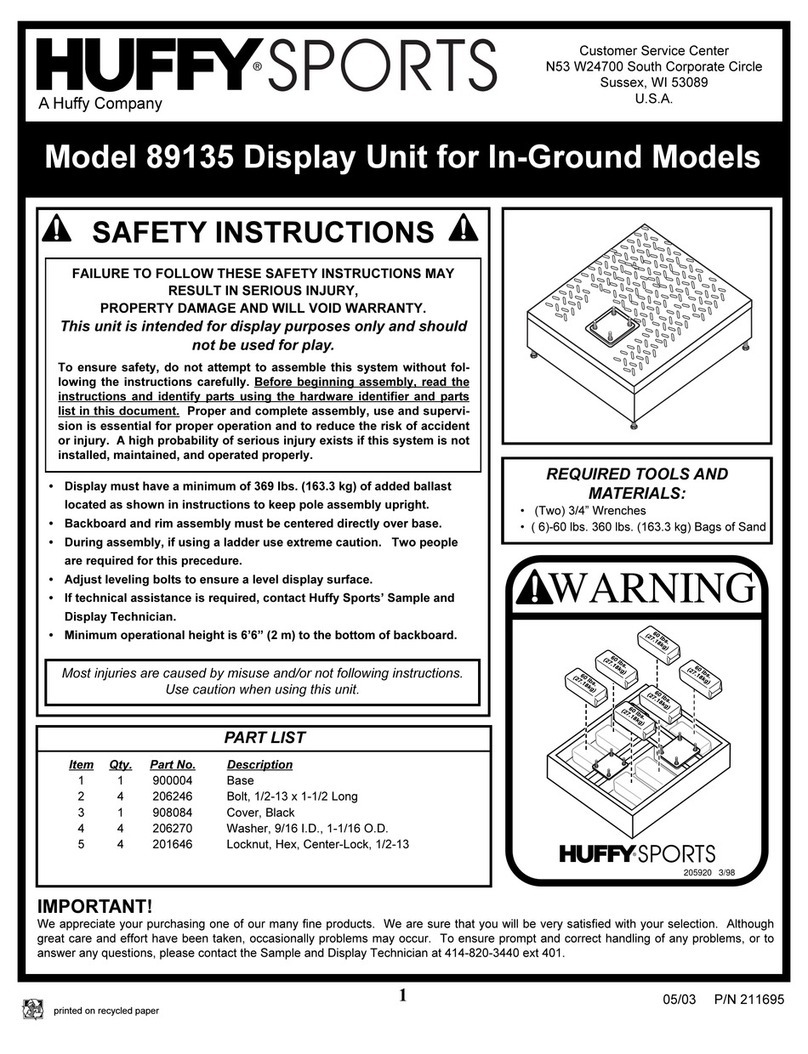DMI Sports Bullshooter Reactor EDBC200 User manual

1.800.399.4402
FAX: 215.283.9573
Please have your model number ready when calling.
DMI Sports Inc
1300 Virginia Drive, Suite 401
Ft. Washington,PA,1903
www.dmisports.com
REACTOR
ELECTRONIC DARTBOARD
MODEL# EDBC200

For any warranty issues or problems,
DO NOT RETURN THIS PRODUCT TO THE STORE WHERE PURCHASED
WARRANTY: This DMI electronic dartboard is guaranteed against defects in materials and
workmanship for 90 days. (Note: flights, shafts and points wear out and/or break as a normal part
of play; this is not a defect and is not covered under the guarantee.) This guarantee is void if
merchandise is misused, abused, neglected, shopworn, scratched or if you cannot provide a valid
proof of purchase.
Opening this dart game will render your warranty null and void
lm over the scoring displayr better
Batteries
This dartboard requires 3 AAA (1.5 volt) Batteries to operate. BATTERIES NOT
INCLUDED. Do NOT mix old and new batteries and do not mix alkaline, standard (carbon
zinc), or rechargeable (nickel cadmium) batteries.
Do not dispose of batteries in fire, batteries may explode or leak.

Mounting Instructions
Choose a location to hang the dartboard where is about 10 feet (3.048 m) of open space in front of the board.
The “toe-line” should be 7’9 1/4” (2.37 M) from the face of the dartboard for steel tip rules or 8 feet for soft
tip rules. You will need to mount the board close to an electric outlet if your dartboard requires an AC adapter.
Always remove the batteries when you use an adapter. Regardless if the dartboard has horizontal or vertical
hang hole(s), the center of bullseye should be 5’8” (1.73 m) from the ground when mounted. (Figure A) Make
a small temporary reference mark on the wall at 5’8 inches from the floor. (do not drill a hole in the temporary
reference mark) Measure the distance between the top hang hole on the back of your board and the center of
the back of your dartboard. The center of the back of the dartboard is the middle point of the circle area on
the back of the board. Take a ruler and determine that distance. Then make the mark for the top hang hole on
the wall above the 5’8 mark by the distance you just measured. (see Figure B) Drill the screw into the mark
you made. Mount the dartboard on the wall by lining up the hang hole on the back with the screw. It may be
necessary to adjust the screws until the board fits snugly against the wall. If you want to mount the dartboard
even more securely to the wall, you can utilize the bottom hang holes located on back of the board as well.
You will need to make another temporary reference mark 12.54 inches below the top hang hole you drilled.
Then make a mark 5.31 “ to the left and another mark 5.31” to the right of the temporary mark for the
additional screw locations. Drill the screws into the two marks you made.
Figure A

FIGURE B
X
X
Wall Stud
5’ 8”
inches
Hang holes :
Measure
center of
board to hang
holes to
determine
how high
above 5’8” to
make hang
hole marks
Floor

Dartboard Functions
POWER button -Press to turn game on or off. Dartboard has an automatic suspend mode to conserve power
and battery life (if using batteries). The dartboard will make sound effect and display “SLEEP” on the display
after approximately 3 minutes of non-use. However, the scores are stored in memory and can be restored by
pressing any button.
START button - This multi-function button is used to:
•START the game when all options have been selected.
•CHANGE to the next player when one player is finished with his round.
This will put dartboard in HOLD status between rounds to allow player to
remove darts from the target area.
GAME buttons -Press to page through the on-screen game menu.
Display Protective Film
This electronic dartboard may have a clear film over the entire display area to prevent scratching during
shipping. It is recommended that this film be removed before play to enhance the display area visibility. To
remove, simply lift edge, peel off, and discard.

Electronic Dartboard Operation
1. Press the POWER button to activate dartboard. A short musical introduction is played as the display goes
through power-up test.
Press GAME buttons until desired game is displayed
2. Press DOUBLE button (optional) to select starting and/or ending on doubles
(used only in 301 - 901 games). This is explained in the game rules section.
3. Press PLAYER button to select the number of players (1, 2, 3, 4, t 1-1, t 2-2,
t 3-3, t 4-4) The default setting is 2 players.
4. Press START button to activate game and begin play.
5. Throw darts
•The dart indicator display is represented by dart icons. The
number of darts displayed indicate the remaining throws for the active
player.
•When all 3 darts have been thrown, a voice command will indicate “next
player” and the score will flash. The darts can now be removed without
affecting the electronic scoring. When all darts are removed from the
playing surface press the STARTbutton to go to next player. Voice
command will indicate which player is up.
Team Play
In addition to scoring for up to 4 players, this dartboard is capable of keeping score for team play up to a
maximum of 4 two-person teams (8 individuals). To enter team play mode, press PLAYER button continually
until a “
t
” appears on the display. Each team option is illustrated below:
t
2-2 2 teams, 4 individual players
(1st team-players 1&3, 2nd team-players 2&4)
t
3-3 3 teams,6 individual players
(1st team-players 1&4, 2nd team-players 2&5, 3rd team-players 3&6
t
4-4 4 teams,8 individual players
(1st team-players 1&5, 2nd team-players 2&6, 3rd team-players 3&7, 4th team-players 4&8)
During team play, team members combine their scores to arrive at a team score.

Caring for your Electronic Dartboard
1. Never use metal tipped darts on this dartboard. Metal tipped darts will seriously damage the circuitry
and electronic operation of this dartboard.
2. Do not use excessive force when throwing darts. Throwing darts too hard will cause frequent tip
breakage and cause excess wear on the board.
3. Turn darts clockwise as you pull them from the board. This makes it easier to remove darts and
extends the life of the tips.
4. Remove the batteries when not in use . This will prolong the life of your batteries.
5. Do not spill liquids on the dartboard. Do not use spray cleaners, or cleaners that contain ammonia or
other harsh chemicals as they may cause damage.
Automatic Suspend Mode Feature
The dartboard will automatically suspend if no action occurs within approximately three minutes. This is
designed to save power or battery life. A sound effect will play and the display will indicate “SLEEP” (see
below). All scores will be stored in memory and play will resume when any button is pressed.
S l -
E e p
Display in Sleep Mode

Solo Play Feature
This exciting feature allows solo player to play against the computer at one of five different levels of
skill – only 1 player can compete against the Solo Play competitor. This adds a level of competition
to normally routine practice sessions.
To activate the Solo Play opponent:
1. Select the Game you wish to play
2. Press SOLO PLAY button
Select Solo Play opponent skill level by pressing the SOLO PLAY button continually
Solo Play Levels
Level 1 Professional
Level 2 Advanced
Level 3 Intermediate
Level 4 Novice
Level 5 Beginner
3. Press START to begin play
When play begins:
The ‘human’ player throws first. After 3 darts are thrown, go to the board to take darts out and press
START to change to the next player (Solo Play). Watch as the Solo Play opponent’s dart scores are
registered on the display. After the Solo Play opponent completes his round, the board will
automatically reset for the “human” player. Play continues until one player wins. Good luck!

Interactive Heckler® Game Play Feature
Your BULLSHOOTER BY ARACHNID® electronic dartboard includes an exciting interactive “Heckler®” feature
that emits rewarding comments of praise for high scoring darts and insults for poorly thrown darts. The
humorous interactive comments are sure to add plenty of fun and excitement to your dart game.
There are four levels to choose from to control how frequent you will hear these interactive sound effects:
FREQUENCY LEVELS
Level 4: Every throw - All throws will include an interactive sound effect
Level 3: Frequently - Frequent interactive sound effects
Level 2: Occasional - Occasional interactive sound effects
Level 1: OFF - Turns OFF the interactive Heckler® sounds
The default setting when the dartboard is turned on is Level 4 (Every Throw) Players do have the ability to
change the frequency level while a game is in process. Simply press the Heckler® button to change the
frequency level.
IMPORTANT! The interactive HECKLER® feature can only be used with standard games of Cricket and ’01
(*301,501 etc)
*Single in and single out games only

GAME MENU
29/90 games
G01
301
G46
Round the clock 1 doubles
G02
401
G47
Round the clock 5 doubles
G03
501
G48
Round the clock 10 doubles
G04
601
G49
Round the clock 15 doubles
G05
701
G50
Round the clock 1 triples
G06
801
G51
Round the clock 5 triples
G07
901
G52
Round the clock 10 triples
G08
Cricket
G53
Round the clock 15 triples
G09
No-score cricket
G54
Killer
G10
Scram
G55
Double down
G11
Cut throat cricket
G56
Double down 41
G12
Adv-cricket
G57
All fives 51
G13
Shooter 6 rounds
G58
All fives 61
G14
Shooter 9 rounds
G59
All fives 71
G15
Shooter 12 rounds
G60
All fives 81
G16
Over 3 lives
G61
All fives 91
G17
Over 5 lives
G62
Shanghai 1
G18
Over 7 lives
G63
Shanghai 5
G19
Unders 3 lives
G64
Shanghai 10
G20
Unders 5 lives
G65
Shanghai 15
G21
Unders 7 lives
G66
Golf-9 holes
G22
Count up 300
G67
Golf-18 holes
G23
Count up 400
G68
Football
G24
Count up 500
G69
Bowling
G25
Count up 600
G70
Baseball-6 inning
G26
Count up 700
G71
Baseball-9 inning
G27
Count up 800
G72
Steeplechase

G28
Count up 900
G73
Shove a penny
G29
Count up 999
G74
Nine dart century
G30
Hi Score (3 rounds)
G75
Green vs Red
G31
Hi Score (4 rounds)
G76
Big Six 3 lives
G32 Hi Score (5 rounds) G77 Big Six 5 lives
G33
Hi Score (6 rounds)
G78
Big Six 7 lives
G34
Hi Score (7 rounds)
G79
Horseshoes 15
G35
Hi Score (8 rounds)
G80
Horseshoes 18
G36
Hi Score (9 rounds)
G81
Horseshoes 21
G37
Hi Score (10 rounds)
G82
Horseshoes 24
G38 Hi Score (11 rounds) G83 Elimination 3 lives
G39
Hi Score (12 rounds)
G84
Elimination 4 lives
G40
Hi Score (13 rounds)
G85
Elimination 5 lives
G41
Hi Score (14 rounds)
G86
Cat & Mouse
G42
Round the clock 1 single
G87
Gold Hunt 12
G43
Round the clock 5 single
G88
Gold Hunt 15
G44 Round the clock 10 single G89 Gold Hunt 18
G45
Round the clock 15 single
G90
Gold Hunt 21

Game Rules
Your BULLSHOOTER BY ARACHNID® electronic dartboard is loaded with games and
options. The rules for each game are detailed below in the order they appear on the scoring
display when paging through the games. The game number is indicated next to each game
for your reference.
301
This popular tournament and pub game is played by subtracting each dart from the starting number (301) until
the player reaches exactly 0 (zero). If a player goes past zero it is considered a “Bust” and the score returns to
where it was at the start of that round. For example, if a player needs a 32 to finish the game and he/she hits a
20, 8, and 10 (totals 38), the score goes back to 32 for the next round.
In playing the game, the double in / double out option can be chosen (double out is the most widely used
option).
•Double In - A double must be hit before points are subtracted from the total.
In other words, a player’s scoring does not begin until a double is hit.
•Double Out - A double must be hit to end the game. This means that an
even number is necessary to finish the game.
•Double In and Double Out - A double is required to start and end scoring
of the game by each player.
401 Starting number 401 701 Starting number 701
501 Starting number 501 801 Starting number 801
601 Starting number 601 901 Starting number 901
CRICKET
Cricket is a strategic game for accomplished players and beginners alike. Players throw for numbers best
suited for them and can force opponents to throw for numbers not as suitable for them. The object of Cricket is
to “close” all of the appropriate numbers before one’s opponent while racking up the highest number of points.
Only the numbers 15 through 20 and the inner/outer bullseye are used. Each player must hit a number 3
times to “open” that segment for scoring (Refer to Tournament Cricket Scoring section for explanation on how
players’ marks are registered). A player is then awarded the number of points of the “open” segment each time
he/she throws a dart that lands in that segment, provided their opponent has not closed that segment. Hitting
the double ring counts as two hits, and the triple ring counts as 3 hits.
Numbers can be opened or closed in any order. A number is “closed” when the other player(s) hit the open
segment 3 times. Once a number has been “closed”, any player for the remainder of the game can no longer
score on it.

Winning - The side closing all the numbers first and accumulating the highest point total is the winner. If a
player “closes” all numbers first but is behind in points, he/she must continue to score on the “open” numbers.
If the player does not make up the point deficit before the opposing player(s) “closes” all the numbers, the
opposing side wins. Play continues until all segments are closed - the winner is the player with the highest
score.
Cricket Scoring Display
This dartboard utilizes a dedicated scoreboard within the scoring display that keeps track of each player’s
segment status when playing Cricket. When Cricket is selected, individual characters will be utilized to
register marks. There are 3 separate lights within each number (15 through 20 and bullseye). During play,
one of the status lights will turn on (black will appear) as a segment is hit. If a double or triple of an active
number is hit, 2 or 3 lights will turn on respectively.
NO-SCORE CRICKET
Same rules as standard Cricket except there is no point scoring. The object of this version is to be the first to
simply “close” all the appropriate numbers (15 through 20 and the bullseye).
SCRAM (For 2 players only)
This game is a variation of Cricket. The game consists of two rounds. The players have a different objective in
each round. In round 1, player 1 tries to “close” (score 3 hits in each segment - 15 to 20 and bullseye). During
this time, player 2 attempts to rack up as many points in the segments that the other player has not yet closed.
Once player 1 has closed all segments, round 1 is complete. In round 2, each player’s roles are reversed.
Now, player 2 tries to close all the segments while player 1 goes for points.
The game is over when round 2 is complete (player 2 closes all segments). The player with the highest point
total is the winner.

CUT-THROAT CRICKET
Same basic rules as standard Cricket except once scoring begins, points are added to your opponent(s) total.
The object of this game is to end up with the fewest points. This variation of Cricket offers a different
psychology to the players. Rather than adding to your own score and helping your own cause as in standard
Cricket, Cut-Throat offers the benefit of racking up points for your opponent(s), digging him in a deeper hole.
Competitive players will love this variation!
Advanced Cricket
This difficult version of cricket was developed for the advanced player. Players must close out the segments
(20,19,18,17,16,15 and bullseye) by using only triples and doubles! In this challenging game, doubles
segments count as 1x the number, and triple segments count as 2x the number. The bullseye scoring is the
same as in standard cricket. The first player to close out the numbers with the most points is the winner.
Shooter
This challenging game tests the players ability to “group together” darts within a segment during each round of
play. The computer will randomly select the segment the players must shoot for at the start of each round –
indicated by a flashing number in the display.
Scoring is as follows: Single segment = 1 Point Double segment = 2 Points
Triple segment = 3 Points Single Bullseye= 4 Points.
When the computer selects players to hit double Bullseye, the outer bull scores 2 points and the inner Bull
scores 4 points. The player with the most points at the end of the rounds is the winner.
Overs
The object of this game is to simply score higher (“over”) than your own previous three dart total score. Before
play begins, players choose the amount of lives to be used by pressing the SELECT button. When a player
fails to score “over “ their previous three-dart total, they will lose one life. When a player “equals” the previous
three dart total, a life will also be lost. The LED screen on the right will light up once for each life taken away.
The last player with a life remaining is the winner.
Unders
This game is the opposite of “Overs” Players must score less (“Under”) than their own previous three-dart total.
The game begins with 180 (highest total possible) when the player shoots higher than his or her own previous
three-dart total, they will lose a life. Each dart that hits outside the scoring area, including bounce outs will be
penalized with 6o points added to your score. The last player with a life remaining is the winner

COUNT-UP 300
The object of this game is to be the first player to reach the specified point total (300). Point total is specified
when the game is selected. Each player attempts to score as many points as possible per round. Doubles and
triples count 2 or 3 times the numerical value of each segment. For example a dart that lands in the triple 20
segment is scored as 60 points. The cumulative scores for each player will be displayed in the LCD display as
the game progresses. Additional variations of this game are detailed below. The rules are the same except
the point total varies as indicated in the number.
COUNT-UP 400 COUNT-UP 800
COUNT-UP 500 COUNT-UP 900
COUNT-UP 600 COUNT-UP 999
COUNT-UP 700
High Score - 3 Rounds
The rules for this competitive game are simple - Rack up the most points in three rounds (nine darts) to win.
Doubles and triples count as 2x and 3x that segment’s score respectively. Additional variations of this game
are detailed below. The rules are the same except the number of rounds varies as indicated in the
number.
High Score - 4 Rounds High Score - 10 Rounds
High Score - 5 Rounds High Score - 11 Rounds
High Score - 6 Rounds High Score - 12 Rounds
High Score - 7 Rounds High Score - 13 Rounds
High Score - 8 Rounds High Score - 14 Rounds
High Score - 9 Rounds
ROUND-THE-CLOCK – r1 singles
Each player attempts to score in each number from 1 through 20 and bullseye in order. Each player throws 3
darts per turn. If a correct number is hit, he/she tries for the next number in sequence. The first player to reach
20 is the winner.
The display will indicate which segment you are shooting for. A player must continue shooting for a segment
until it is hit. The display will then indicate the next segment you should shoot for.
There are many difficulty settings available for this game. Each game has the same rules, the differences are
detailed as follows:
ROUND-THE-CLOCK 5 -Game starts at segment number 5
ROUND-THE-CLOCK 10 -Game starts at segment number 10
ROUND-THE-CLOCK 15 - Game starts at segment number 15
Since this game does not utilize point scoring, the double and triple rings count
as single numbers.

We have added some additional levels of difficulty to this game for those looking for a
real challenge!:
ROUND-THE-CLOCK Double - Player must score a Double in each segment from 1 through 20 in order.
ROUND-THE-CLOCK Double 5 -Game starts at double segment 5
ROUND-THE-CLOCK Double 10 -Game starts at double segment 10
ROUND-THE-CLOCK Double 15 - Game starts at double segment 15
ROUND-THE-CLOCK Triple - Player must score a Triple in each segment from 1 through 20 in order.
ROUND-THE-CLOCK Triple 5 -Game starts at triple segment 5
ROUND-THE-CLOCK Triple 10 -Game starts at triple segment 10
ROUND-THE-CLOCK Triple 15 - Game starts at triple segment 15
KILLER
This game will really show who your friends are. The game can be played with as few as two players, but the
excitement and challenge builds with even more players. To start, each player must select his number by
throwing a dart at the target area. The LCD display will indicate “SEL” at this point. The number each player
gets is his assigned number throughout the game. No two players can have the same number. Once each
player has a number, the action starts.
Your first objective is to establish yourself as a “Killer” by hitting the double segment of your number. Once
your double is hit, you are a “Killer” for the rest of the game. Now, your objective is to “kill” your opponents by
hitting their segment number until all their “lives” are lost. The last player to remain with lives is declared the
winner. It is not uncommon for players to “team up” and go after the better player to knock him out of the
game.
DOUBLE DOWN
Each player starts the game with 40 points. The object is to score as many hits in the active segment of the
current round. The first round, the player must throw for the 15 segment. If no 15’s are hit, his score is cut in
half. If some 15’s are hit, each 15 (doubles and triples count) is added to the starting total. The next round
players throw for the 16
segment and hits are added to the new cumulative point total. Again, if no hits are registered, the point total is
cut in half.
Each player throws for the numbers as indicated in the chart below in order (the LCD screen will indicate the
active segment in which to throw). The player who completes the game with the most points is the winner.
15 16 D 17 18 T 19 20 B TOTAL
Player 1
Player 2
Any Double
Any Triple

DOUBLE DOWN 41
This game follows similar rules as standard Double Down as described above with two exceptions. First,
instead of going from 15 through 20 and bullseye, the sequence is reversed which will be indicated on the
LCD display. Second, an additional round is included toward the end in which players must attempt to score
three hits that add up to 41 points (20, 20, 1; 19, 19, 3; D10, D10, 1: etc.). This “41” round adds an extra level
of difficulty to the game. Remember, a player’s score is cut in half if not successful, so the “41” round
presents quite a challenge!
20 19 D 18 17 T 16 15 41 B TOTAL
Player 1
Player 2
ALL FIVES - 51
The entire board is in-play for this game (all segments are active). With each round (of 3 darts) each player
has to score a total which is divisible by 5. Every “five” counts as one point. For example 10, 10, 5 = 25.
Since 25 is divisible by 5 fives, this player scores 5 points (5 x 5 = 25).
If a player throws 3 darts that are not divisible by 5, no points are given. Also, the last dart of each round must
land in a segment. If a player throws the third dart and it lands in the catch ring area (or misses the board
completely), he earns no points even if the first two
Darts are divisible by 5. This prevents a player from “tanking” the third throw if his first two are good. The first
player to total fifty-one (51) “fives” is the winner. The LCD screen will keep track of the point totals. Additional
variations of this game are detailed below. The rules are the same except the total needed to win varies
as indicated in the number following the game.
ALL FIVES - 61 ALL FIVES - 81
ALL FIVES - 71 ALL FIVES - 91
SHANGHAI - 1
Each player must progress around the board from 1 through 20 in order. Players start at number 1 and throw 3
darts. The object is to score the most points possible in each round of 3 darts. Doubles and triples count
toward your score. The player with the highest score after completing all twenty segments is the winner.
Additional variations of this game are detailed below. The rules are the same except the starting
segment varies as indicated in the number following the game.
SHANGHAI 5 -Game starts at segment 5
SHANGHAI 10 -Game starts at segment 10
SHANGHAI 15 - Game starts at segment 15
Any Double
Any Triple
‘41’ Round

GOLF – 9 Holes
This is a dartboard simulation of the game golf (but you don’t need clubs to play). The object is to complete a
round of 9 through 18 “holes” with the lowest score possible. The Championship “course” consists of all par
3 holes making par 27 for a nine hole round or 54 for a round of 18.
The segments 1 through 18 are used with each number representing a “hole.” You must score 3 hits in each
hole to move to the next hole. Obviously, double and triples affect your score as they allow you to finish a hole
with fewer strokes. For example, throwing a triple on the first shot of a hole it is counted as an “eagle” and that
player gets to complete that hole with 1 “stroke.”
Note: The active player continues to throw darts until he “holes out” (scores 3 hits on the current hole). The
voice announcer will indicate the player that is up - listen carefully to avoid shooting out of sequence. By the
way, there are no “gimmes” in this game! Additional variations of this game are detailed below. The rules
are the same except the number of holes needed to play.
GOLF – 18 Holes – Same as above except play lasts 18 holes (rounds)
FOOTBALL
Strap your helmet on for this game! The first thing necessary is to select each player’s “playing field.” Each
player can do this by throwing a dart or by manually pressing a segment on the board. This is entirely up to
you, but whichever segment is selected it
becomes your starting point which carries through the bullseye and directly across to the other side of the
bullseye.
For example, if you select the 20 segment, you start on the double 20 (outer ring) and continue all the way
through to the double 3. The “field” is made up of 11 individual segments and must be hit in order. So,
keeping with the example above, you must throw darts in the following segments in this order:
Double 20 ... Outer Single 20 ... Triple 20 ... Inner Single 20 ...
Outer Bullseye ... Inner Bullseye ... Outer Bullseye ... Inner Single 3 ...
Triple 3 ... Outer Single 3 ... and finally a Double 3.
The First player to “score” is the winner. The LED display will keep track of your progress and indicate the
segment you need to throw for next.

BOWLING
This dartboard adaptation of bowling
is a real challenge! It is a difficult game
in that you must be very accurate to rack
up a decent score. Player one starts the
game. You must select your “alley” by
either throwing dart or manually pressing
segment of choice. Once alley is selected,
you have 2 remaining darts to throw in
which to score points or “pins.” Each
specific segment in your “alley” is worth a
given pin total:
Segment Score
Double 9 pins
Outer Single 3 pins
Triple 10 pins
Inner Single 7 pins
There are several rules for this game as follows:
1. A perfect game score would be 200 in this version of bowling
2. You cannot hit the same singles segment twice within the same “frame” (round). The second hit will count
as zero points. Hint: Try to hit each single to reach 10 points in the frame.
3. You can score 20 points per “frame” by hitting the triple segment twice.
4. Hitting the double segment with your second dart will only count as 10 points if you scored a double on
your first throw. Otherwise you will score a total of 9 points by throwing a double with your second dart.

BASEBALL – 6 Innings
This dartboard version of baseball takes
a great deal of skill. As in the real game,
a complete game consists of 9 innings.
Each player throws 3 darts per “inning.”
The field is laid out as shown in the diagram.
Segment Result____________
Singles segments “Single” - one base
Doubles segment “Double” - two bases
Triples segment “Triple” - Three bases
Bullseye “Home Run” (can only
be attempted on third
dart of each round)
The object of the game is to score as many runs as possible each inning. The player with the most runs at the
end of the game is the winner.
BASEBALL – 9 Innings – Same as above except 9 innings (rounds).
STEEPLECHASE
The object of this game is to be the first player to finish the “race” by being the first to complete the “track.” The
track starts at the 20 segment and runs clockwise around the board to the 5 segment and ends with a bullseye.
Sounds easy right? What has not yet been specified is that you must hit the inner single segment of each
number to get through the course. This is the area between the bullseye and the triples ring. And, as with a
real
steeplechase, there are obstacles throughout the course to hurdle. The four hurdles are found at the following
places:
•1st fence Triple 13 •2nd fence Triple 17
•3rd fence Triple 8 •4th fence Triple 5
The first player to complete the course and hit the bullseye wins the race.
SHOVE A PENNY
Only the numbers 15 through 20 and the bullseye are used. Singles are worth 1 point, doubles are worth 2,
and triples are worth 3 points. Each player must throw for the numbers in order with the objective of scoring 3
points in each segment to move on to the next. If a player scores more than 3 points in any one number, the
excess points are given to the next player. The first player to score 3 points in all segments (15 - 20 and bull)
is the winner.
Table of contents

